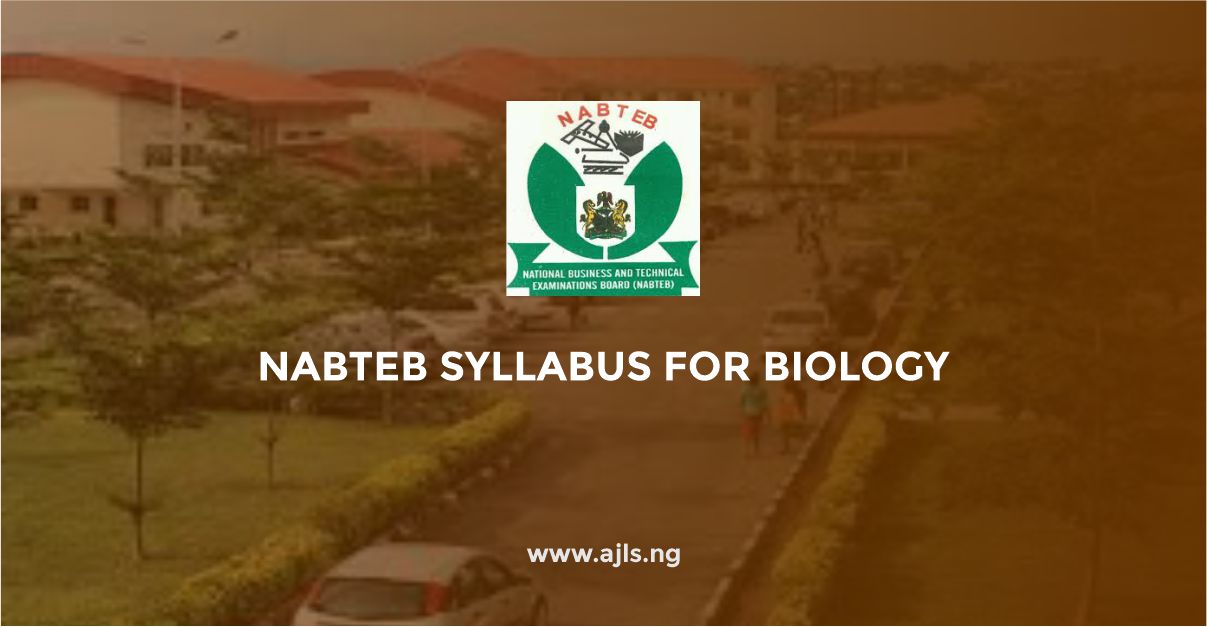NABTEB Syllabus for Biology 2025

Are you aspiring to write NABTEB and looking for a comprehensive syllabus for Biology? The NABTEB Syllabus for Biology is an essential resource for students aiming to write the National Business and Technical Examinations Board assessments. It delineates the scope of topics to be covered, ranging from fundamental biological principles to more advanced concepts such as genetics and ecology.
Each topic is accompanied by specific objectives, guiding students on the expected learning outcomes and providing a clear roadmap for study. This targeted approach enables students to focus their studies efficiently, ensuring comprehensive coverage of the subject matter and enhancing their preparedness for the examinations.
If you are a candidate and you have registered for NABTEB or you are about to register for the examination with the intention of writing Biology as one of the subjects then you should read carefully through the information provided to know the examination structure, the distribution of marks, the types of questions to anticipate, and the recommended textbooks to read.
A Comprehensive Outline of NABTEB Syllabus for Biology
Below is a comprehensive outline of the NABTEB Biology syllabus presented in a table format for clarity. This outline is based on the standard topics typically covered in the NABTEB Biology curriculum.
| S/N | Topic | Subtopics | Objectives |
|---|---|---|---|
| 1 | Cell Structure and Organization | Cell types (prokaryotic and eukaryotic) <br> – Cell organelles and their functions <br> – Differences between plant and animal cells | Identify and describe the structure and functions of cell components <br> – Differentiate between plant and animal cells |
| 2 | Classification of Living Organisms | Five kingdoms of life <br> – Binomial nomenclature <br> – Hierarchical classification system | Classify organisms based on shared characteristics <br> – Apply binomial nomenclature in naming organisms |
| 3 | Nutrition | Autotrophic and heterotrophic nutrition <br> – Photosynthesis process <br> – Human digestive system and nutrition | Explain different modes of nutrition <br> – Describe the process of photosynthesis <br> – Understand the human digestive system |
| 4 | Respiration | Aerobic and anaerobic respiration <br> – Energy production <br> – Respiratory organs in animals and plants | Differentiate between aerobic and anaerobic respiration <br> – Identify respiratory structures in various organisms |
| 5 | Transport System | Transport in plants (xylem and phloem) <br> – Circulatory system in humans <br> – Blood components and functions | Describe transport mechanisms in plants and animals <br> – Understand the human circulatory system |
| 6 | Excretion | Excretory organs in humans <br> – Excretion in plants <br> – Waste products and their elimination | Identify excretory organs and their functions <br> – Explain excretion processes in plants and animals |
| 7 | Growth and Development | Cell division (mitosis and meiosis) <br> – Growth patterns in plants and animals <br> – Factors affecting growth | Understand the processes of cell division <br> – Describe growth patterns and influencing factors |
| 8 | Reproduction | Asexual and sexual reproduction <br> – Human reproductive system <br> – Reproductive processes in plants | Differentiate between types of reproduction <br> – Explain human and plant reproductive systems |
| 9 | Genetics | Mendelian genetics <br> – Chromosomes and genes <br> – Inheritance patterns | Understand basic genetic principles <br> – Solve simple genetic problems |
| 10 | Evolution | Theories of evolution <br> – Evidence supporting evolution <br> – Natural selection | Discuss various evolutionary theories <br> – Identify evidence supporting the theory of evolution |
| 11 | Ecology | Ecosystems and their components <br> – Food chains and webs <br> – Energy flow and nutrient cycles | Describe ecosystem components and interactions <br> – Understand energy flow and nutrient cycling |
| 12 | Adaptation | Structural, behavioral, and physiological adaptations <br> – Adaptations in plants and animals to their environments | Identify different types of adaptations <br> – Explain how adaptations aid survival |
| 13 | Conservation of Natural Resources | Importance of conservation <br> – Methods of conserving resources <br> – Roles of individuals and governments | Understand the need for conservation <br> – Discuss conservation strategies and responsibilities |
| 14 | Pollution | Types of pollution (air, water, soil, noise) <br> – Sources and effects of pollution <br> – Control measures | Identify various pollutants and their sources <br> – Explain the effects of pollution and control methods |
| 15 | Microorganisms and Disease | Types of microorganisms <br> – Beneficial and harmful microorganisms <br> – Disease transmission and prevention | Classify microorganisms <br> – Understand their roles in health and disease |
| 16 | Practical Biology | Laboratory techniques <br> – Microscopy <br> – Conducting experiments and recording observations | Develop practical skills in biological investigations <br> – Accurately record and interpret exp |
NABTEB Biology Examination Structure
The NABTEB Biology Examination Structure is organized to assess both theoretical knowledge and practical skills. Here’s a detailed breakdown of the structure:
Paper I: Objective (Multiple Choice)
- Format: 50 multiple-choice questions
- Duration: 1 hour
- Marks: 50 marks
- Focus: This section tests candidates’ breadth of knowledge across the entire syllabus, covering definitions, concepts, and applications of biological principles.
Paper II: Essay (Theory)
- Format: Structured and essay-type questions (usually divided into two sections, A and B)
- Duration: 1 hour 30 minutes
- Marks: 80 marks
- Section A: Compulsory questions based on core topics
- Section B: Candidates answer a set number of questions (e.g., 3 out of 5), focusing on broader understanding and the ability to communicate biological ideas.
Paper III: Practical
- Format: Hands-on laboratory-based questions
- Duration: 1 hour 30 minutes
- Marks: 50 marks
- Content: Involves identification of specimens, drawing and labeling diagrams, performing simple experiments, and answering related theoretical questions.
Total Marks: 180
- Grading: The final grade is determined by the cumulative score from all three papers.
This examination structure ensures a balanced assessment of cognitive understanding, analytical ability, and practical competence, which are essential in biological sciences.
Recommended Biology Textbooks for NABTEB Candidates
- College Biology by Idodo-Umeh, G. A comprehensive textbook tailored for West African students, covering all essential topics in the NABTEB Biology syllabus.
- Essential Biology for Senior Secondary Schools by M.C. Michael. Provides clear explanations of biological concepts, complemented by diagrams and practice questions to enhance understanding.
- Biology for Senior Secondary Schools by M.C. Michael. Offers in-depth coverage of biology topics, aligning well with the NABTEB curriculum.
- Modern Biology for Senior Secondary Schools by S.T. Ramalingam. A widely used textbook that presents biology concepts in a student-friendly manner, with illustrations and review questions.
- Comprehensive Practical Biology for Senior Secondary Schools by G.N.C. Egwu. Focuses on the practical aspects of biology, providing detailed procedures and experiments relevant to the NABTEB practical examination.
Supplementary Materials
- Past Question Papers and Marking Schemes. Practicing with past NABTEB Biology questions can help students familiarize themselves with the examination format and question styles.
- Study Guides and Revision Books. Utilizing study guides that summarize key concepts and offer practice questions can aid in effective revision.
Conclusion
The NABTEB Syllabus for Biology serves as a comprehensive framework designed to equip students with essential biological knowledge, practical skills, and scientific reasoning. By covering a wide range of topics from cell biology to ecology and genetics it prepares candidates not only for academic excellence but also for meaningful application of biology in real-world contexts such as health, agriculture, and environmental conservation. With its balance of theory and practical work, the syllabus fosters critical thinking and lays a strong foundation for further studies or careers in the biological sciences.





